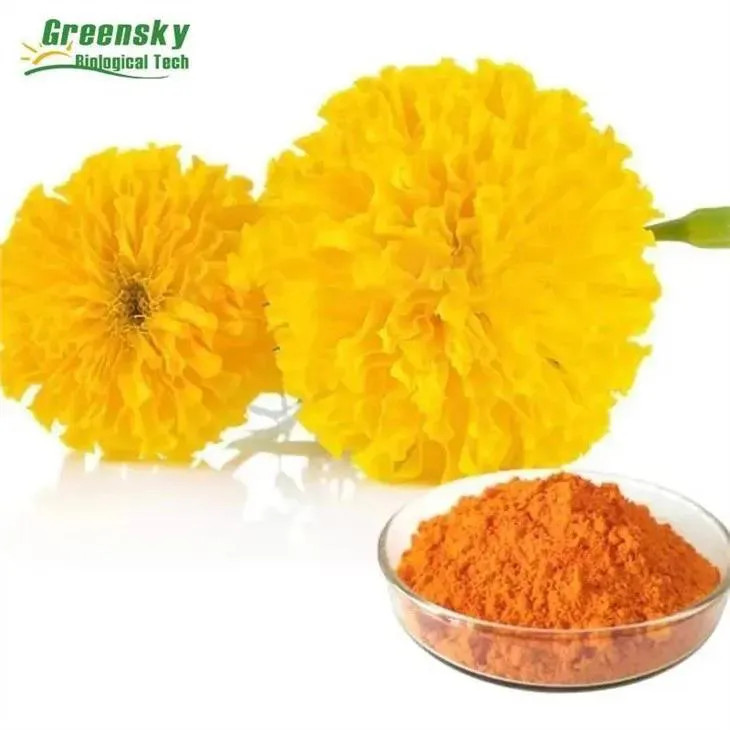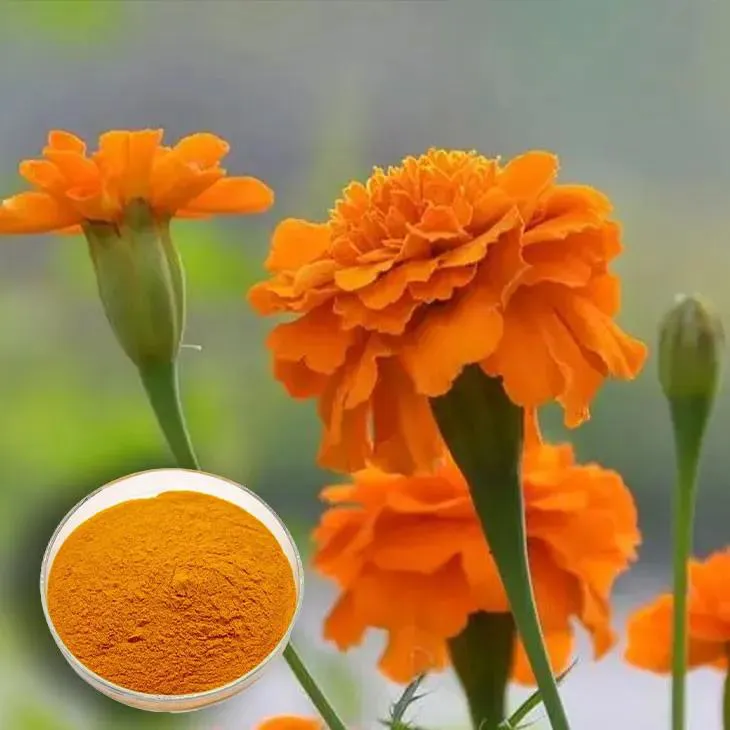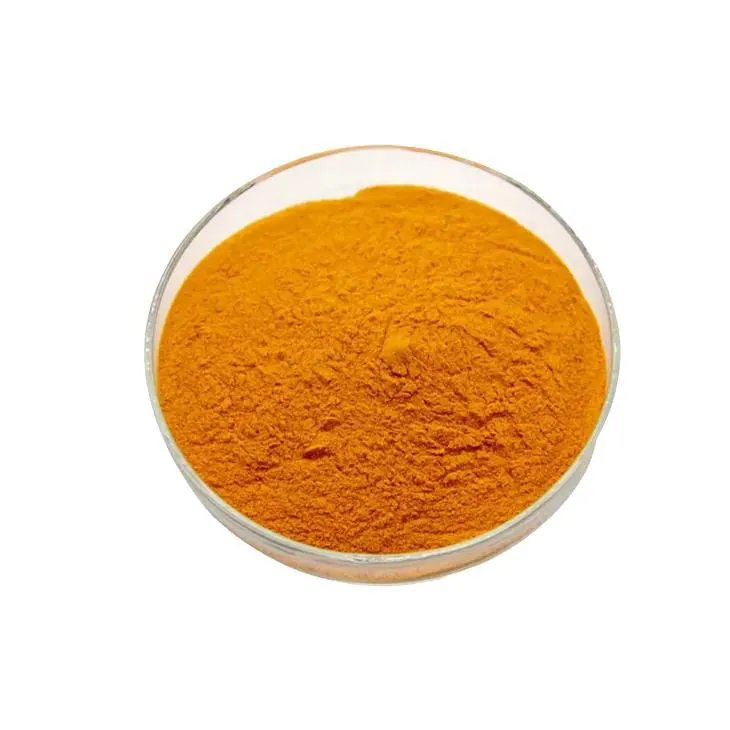- 0086-571-85302990
- sales@greenskybio.com
How to make powder from marigold extract?
2024-11-26

1. Introduction
Marigold Extract is rich in various beneficial compounds such as flavonoids and carotenoids. Converting this extract into powder form has numerous advantages, including easier storage, transportation, and wider application in different industries. This comprehensive guide will explore the process of making powder from Marigold Extract, covering important aspects such as proper extraction techniques, factors affecting powder quality, and potential applications of the resulting powder.

2. Proper Extraction Techniques
2.1. Selection of Marigold
The first step in obtaining a high - quality Marigold Extract for powder production is the proper selection of marigolds. Fresh and healthy marigolds should be chosen. The variety of marigold also plays a role. For example, Tagetes erecta is commonly used due to its relatively high content of active compounds. Marigolds should be free from diseases, pests, and any signs of decay.
2.2. Solvent Extraction
- One of the most common methods for extracting compounds from marigolds is solvent extraction. Organic solvents such as ethanol or hexane are often used. Ethanol is a popular choice as it is relatively safe and can effectively extract a wide range of compounds.
- The marigold flowers are typically dried and ground into a fine powder before the extraction process. This increases the surface area available for the solvent to interact with the plant material.
- The ground marigold powder is then mixed with the solvent in a suitable ratio. For example, a ratio of 1:5 (marigold powder to solvent) may be used. The mixture is then stirred continuously for a specific period, usually several hours, to ensure proper extraction.
- After the extraction period, the mixture is filtered to separate the liquid extract from the solid residue. This can be done using filter paper or a filtration apparatus.
2.3. Supercritical Fluid Extraction
- Supercritical fluid extraction is another advanced technique. Carbon dioxide (CO₂) in its supercritical state is often used. This method has the advantage of being more environmentally friendly compared to some organic solvents.
- The marigold material is placed in an extraction vessel, and the supercritical CO₂ is passed through it. The pressure and temperature are carefully controlled to ensure that the CO₂ is in its supercritical state. This allows it to act as a solvent and extract the desired compounds from the marigolds.
- The advantage of supercritical fluid extraction is that it can produce a cleaner extract with fewer impurities. However, the equipment required for this method is more expensive and complex.

3. Factors Influencing Powder Quality
3.1. Purity of the Extract
The purity of the marigold extract is crucial in determining the quality of the final powder. A high - purity extract, free from contaminants such as pesticides, heavy metals, and other unwanted plant materials, will result in a higher - quality powder. During the extraction process, proper filtration and purification steps should be taken to ensure the purity of the extract.
3.2. Drying Method
- Once the extract is obtained, the drying method used to convert it into powder has a significant impact on powder quality. Spray drying is a commonly used method. In spray drying, the liquid extract is sprayed into a hot drying chamber. The hot air quickly evaporates the liquid, leaving behind fine powder particles. This method can produce a powder with a relatively uniform particle size and good flow properties.
- Another method is freeze - drying. Freeze - drying involves freezing the extract first and then removing the water by sublimation under low pressure. Freeze - dried powder often retains more of the active compounds' functionality as it undergoes less thermal degradation compared to spray - dried powder. However, freeze - drying is more expensive and time - consuming.
3.3. Particle Size
The particle size of the powder affects its physical properties such as solubility, flowability, and dispersibility. A smaller particle size generally results in better solubility and dispersibility. To control the particle size, techniques such as milling or sieving can be used after the powder is initially formed. Milling can further break down larger particles, while sieving can separate out particles of a desired size range.

4. Potential Applications of the Resultant Powder
4.1. Food Industry
- In the food industry, marigold extract powder can be used as a natural food colorant. The pigments present in the marigold, such as lutein and zeaxanthin, can give a yellow - orange color to food products. It can be used in products like baked goods, dairy products, and confectionery.
- It also has potential as a nutritional supplement. Marigold - derived compounds are known for their antioxidant properties, which can help in preventing oxidative damage in the body. Thus, it can be added to functional foods or dietary supplements.
4.2. Cosmetic Industry
- The powder can be used in cosmetic products for its antioxidant and anti - inflammatory properties. It can be incorporated into creams, lotions, and serums. For example, the carotenoids in marigold extract can help protect the skin from UV - induced damage and reduce inflammation.
- Marigold extract powder can also be used as a natural colorant in cosmetics, providing a yellow - orange hue to products such as lipsticks and blushes.
4.3. Pharmaceutical Industry
- Some of the compounds in marigold extract have shown potential in pharmaceutical applications. For example, they may have anti - cancer properties or be used in the treatment of eye diseases due to the presence of lutein and zeaxanthin. The powder form can be more easily formulated into tablets, capsules, or other dosage forms.
- Marigold - based powders can also be used in traditional medicine preparations. In some cultures, marigolds have been used for their medicinal properties for centuries, and the powder form can make it easier to standardize and distribute these traditional remedies.

5. Conclusion
Making powder from marigold extract involves a series of important steps from proper extraction techniques to careful consideration of factors affecting powder quality. The resultant powder has a wide range of potential applications in the food, cosmetic, and pharmaceutical industries. By understanding and controlling the various aspects of the production process, it is possible to produce high - quality marigold extract powder that can be utilized effectively in different fields.
FAQ:
Q1: What are the proper extraction techniques for marigold extract?
Proper extraction techniques for marigold extract often involve solvent extraction. Commonly, organic solvents like ethanol are used. The marigold flowers are first dried and then soaked in the solvent for a period. This allows the active compounds in the marigold, such as carotenoids, to dissolve into the solvent. Another method could be supercritical fluid extraction which uses carbon dioxide under specific pressure and temperature conditions to extract the desired components more efficiently while being relatively more environmentally friendly.
Q2: How do extraction techniques affect the quality of the marigold powder?
If the extraction is not done properly, for example, if the wrong solvent is used or the extraction time is too short or too long, it can lead to an incomplete extraction of the active ingredients. This will result in a powder with lower potency. Incomplete extraction may also leave behind unwanted substances that can affect the purity of the powder. On the other hand, over - extraction can cause degradation of some sensitive compounds. So, precise control of extraction parameters like temperature, solvent concentration, and extraction time is crucial for high - quality marigold powder.
Q3: What are the factors influencing the quality of marigold powder?
Besides the extraction techniques, the quality of the starting marigold material matters. If the marigolds are not fresh or are contaminated, it will impact the powder quality. The drying process after extraction also plays a role. If the drying is too rapid or at a very high temperature, it can cause the active compounds to degrade. Storage conditions of the powder, such as exposure to light, moisture, and air, can also lead to oxidation and degradation of the components in the powder.
Q4: What are the potential applications of marigold powder?
Marigold powder has several potential applications. In the food industry, it can be used as a natural colorant due to its rich content of carotenoids. In cosmetics, it can be added to creams and lotions for its antioxidant properties which may help in skin health. In the pharmaceutical field, it may have potential anti - inflammatory and antimicrobial properties, and could be used in the development of herbal medicines or dietary supplements.
Q5: How can one ensure the purity of marigold powder?
To ensure the purity of marigold powder, start with high - quality marigold raw materials. Use proper extraction and purification techniques. After extraction, filtration and centrifugation can be used to remove solid impurities. Chromatographic techniques can also be employed for further purification if needed. During the drying process, ensure that the equipment is clean and free from contaminants. Also, store the powder in appropriate containers that are airtight and protect from light and moisture.
Related literature
- Optimization of Marigold (Tagetes erecta L.) Extract Production for Food Coloring Purposes"
- "The Chemical Composition and Bioactivity of Marigold (Tagetes spp.) Extracts"
- "Marigold Extract: From Plant to Powder - A Review of Industrial Processes"
- ▶ Hesperidin
- ▶ citrus bioflavonoids
- ▶ plant extract
- ▶ lycopene
- ▶ Diosmin
- ▶ Grape seed extract
- ▶ Sea buckthorn Juice Powder
- ▶ Beetroot powder
- ▶ Hops Extract
- ▶ Artichoke Extract
- ▶ Reishi mushroom extract
- ▶ Astaxanthin
- ▶ Green Tea Extract
- ▶ Curcumin Extract
- ▶ Horse Chestnut Extract
- ▶ Other Problems
- ▶ Boswellia Serrata Extract
- ▶ Resveratrol Extract
- ▶ Marigold Extract
- ▶ Grape Leaf Extract
- ▶ blog3
- ▶ blog4
-
Chinese Withania somnifera Extract Factory.
2024-11-26
-
中国松树皮提取物粉粉末供应商
2024-11-26
-
High - quality Marigold Extract Products.
2024-11-26
-
100% Pure Natural Mango - Flavored Powder.
2024-11-26
-
Shikonin
2024-11-26
-
Maca Extract
2024-11-26
-
melatonin extract
2024-11-26
-
Shikone Extract
2024-11-26
-
Jujube Extract
2024-11-26
-
Alisma Extract
2024-11-26
-
Lemon Balm Extract
2024-11-26
-
Eucommia Ulmoides Extract
2024-11-26
-
Sea buckthorn Juice Powder
2024-11-26
-
Phyllanthus Emblica Extract
2024-11-26





















